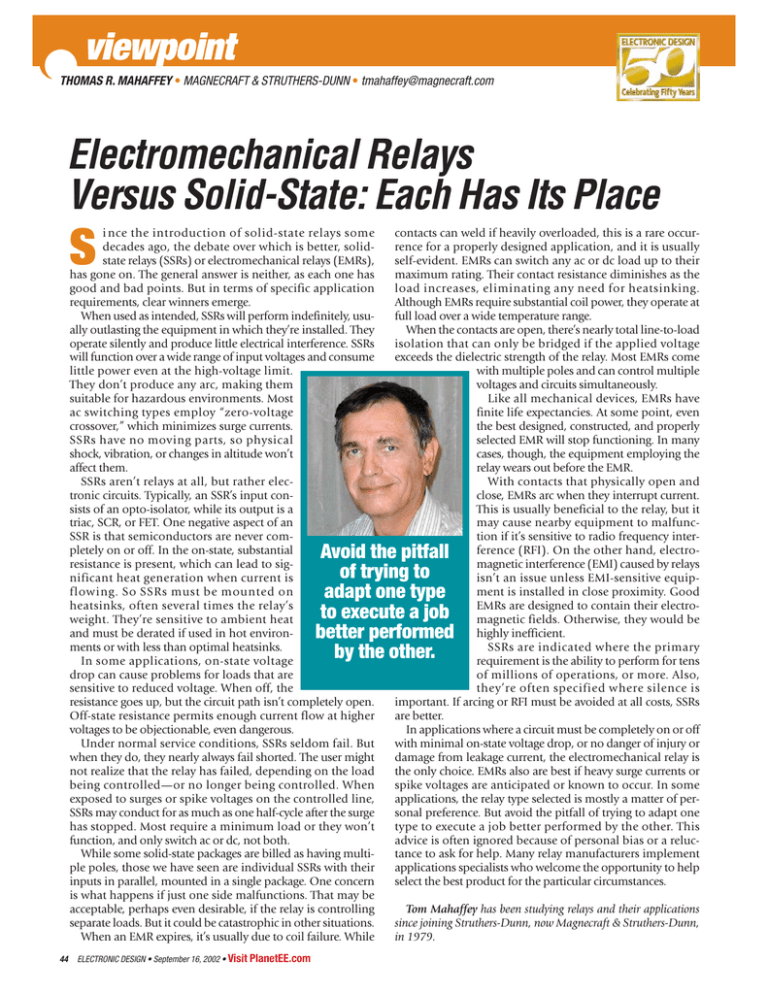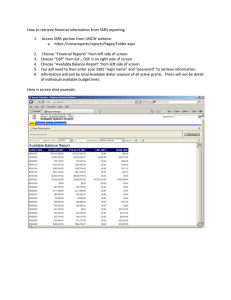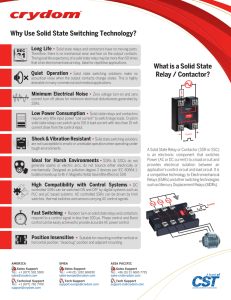Electromechanical Relays Versus Solid-State: Each Has
advertisement

viewpoint THOMAS R. MAHAFFEY • MAGNECRAFT & STRUTHERS-DUNN • tmahaffey@magnecraft.com Electromechanical Relays Versus Solid-State: Each Has Its Place i nce the introduction of solid-state relays some decades ago, the debate over which is better, solidstate relays (SSRs) or electromechanical relays (EMRs), has gone on. The general answer is neither, as each one has good and bad points. But in terms of specific application requirements, clear winners emerge. When used as intended, SSRs will perform indefinitely, usually outlasting the equipment in which they’re installed. They operate silently and produce little electrical interference. SSRs will function over a wide range of input voltages and consume little power even at the high-voltage limit. They don’t produce any arc, making them suitable for hazardous environments. Most ac switching types employ “zero-voltage crossover,” which minimizes surge currents. SSRs have no moving parts, so physical shock, vibration, or changes in altitude won’t affect them. SSRs aren’t relays at all, but rather electronic circuits. Typically, an SSR’s input consists of an opto-isolator, while its output is a triac, SCR, or FET. One negative aspect of an SSR is that semiconductors are never completely on or off. In the on-state, substantial resistance is present, which can lead to significant heat generation when current is flowing. So SSRs must be mounted on heatsinks, often several times the relay’s weight. They’re sensitive to ambient heat and must be derated if used in hot environments or with less than optimal heatsinks. In some applications, on-state voltage drop can cause problems for loads that are sensitive to reduced voltage. When off, the resistance goes up, but the circuit path isn’t completely open. Off-state resistance permits enough current flow at higher voltages to be objectionable, even dangerous. Under normal service conditions, SSRs seldom fail. But when they do, they nearly always fail shorted. The user might not realize that the relay has failed, depending on the load being controlled—or no longer being controlled. When exposed to surges or spike voltages on the controlled line, SSRs may conduct for as much as one half-cycle after the surge has stopped. Most require a minimum load or they won’t function, and only switch ac or dc, not both. While some solid-state packages are billed as having multiple poles, those we have seen are individual SSRs with their inputs in parallel, mounted in a single package. One concern is what happens if just one side malfunctions. That may be acceptable, perhaps even desirable, if the relay is controlling separate loads. But it could be catastrophic in other situations. When an EMR expires, it’s usually due to coil failure. While S contacts can weld if heavily overloaded, this is a rare occurrence for a properly designed application, and it is usually self-evident. EMRs can switch any ac or dc load up to their maximum rating. Their contact resistance diminishes as the load increases, eliminating any need for heatsinking. Although EMRs require substantial coil power, they operate at full load over a wide temperature range. When the contacts are open, there’s nearly total line-to-load isolation that can only be bridged if the applied voltage exceeds the dielectric strength of the relay. Most EMRs come with multiple poles and can control multiple voltages and circuits simultaneously. Like all mechanical devices, EMRs have finite life expectancies. At some point, even the best designed, constructed, and properly selected EMR will stop functioning. In many cases, though, the equipment employing the relay wears out before the EMR. With contacts that physically open and close, EMRs arc when they interrupt current. This is usually beneficial to the relay, but it may cause nearby equipment to malfunction if it’s sensitive to radio frequency interference (RFI). On the other hand, electromagnetic interference (EMI) caused by relays isn’t an issue unless EMI-sensitive equipment is installed in close proximity. Good EMRs are designed to contain their electromagnetic fields. Otherwise, they would be highly inefficient. SSRs are indicated where the primary requirement is the ability to perform for tens of millions of operations, or more. Also, they’re often specified where silence is important. If arcing or RFI must be avoided at all costs, SSRs are better. In applications where a circuit must be completely on or off with minimal on-state voltage drop, or no danger of injury or damage from leakage current, the electromechanical relay is the only choice. EMRs also are best if heavy surge currents or spike voltages are anticipated or known to occur. In some applications, the relay type selected is mostly a matter of personal preference. But avoid the pitfall of trying to adapt one type to execute a job better performed by the other. This advice is often ignored because of personal bias or a reluctance to ask for help. Many relay manufacturers implement applications specialists who welcome the opportunity to help select the best product for the particular circumstances. Avoid the pitfall of trying to adapt one type to execute a job better performed by the other. 44 ELECTRONIC DESIGN • September 16, 2002 • Visit PlanetEE.com Tom Mahaffey has been studying relays and their applications since joining Struthers-Dunn, now Magnecraft & Struthers-Dunn, in 1979.



